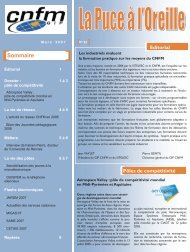Étude de la réalisation d'un thermocycleur assisté par onde ... - Cnfm
Étude de la réalisation d'un thermocycleur assisté par onde ... - Cnfm
Étude de la réalisation d'un thermocycleur assisté par onde ... - Cnfm
Create successful ePaper yourself
Turn your PDF publications into a flip-book with our unique Google optimized e-Paper software.
K² (%)<br />
Figure 7. Micro-Système en cour <strong>de</strong> développement<br />
6,5<br />
6<br />
5,5<br />
5<br />
4,5<br />
4<br />
3,5<br />
Figure 8. Simu<strong>la</strong>tion du coefficient <strong>de</strong> coup<strong>la</strong>ge en<br />
fonction <strong>de</strong> l'épaisseur normalisée <strong>de</strong> <strong>la</strong> couche <strong>de</strong><br />
nitrure d'aluminium avec un substrat <strong>de</strong> niobate <strong>de</strong><br />
lithium <strong>de</strong> coupe Y+128° et <strong>de</strong> direction <strong>de</strong><br />
propagation X, h est l’épaisseur d’AlN et k=2.π/λ.<br />
conductrice thermiquement qui nous permet <strong>de</strong> p<strong>la</strong>cer<br />
directement notre microgoutte sur les électro<strong>de</strong>s.<br />
Nous avons choisi le nitrure d’aluminium (AlN) pour<br />
ces propriétés thermique et iso<strong>la</strong>nte adéquates. La<br />
microgoutte capte donc toute l’énergie <strong>de</strong> l’on<strong>de</strong> <strong>de</strong><br />
Rayleigh. Des simu<strong>la</strong>tions nous ont montré qu’une faible<br />
épaisseur d’AlN ne dégra<strong>de</strong> pas notre on<strong>de</strong> mais améliore<br />
le coefficient <strong>de</strong> coup<strong>la</strong>ge (Figure 8), ce qui correspond<br />
aux simu<strong>la</strong>tions <strong>de</strong> Ro et al. [13]. Pour une epaisseur<br />
d’AlN normalisée <strong>de</strong> 0,06, le coefficient <strong>de</strong> coup<strong>la</strong>ge<br />
atteind 6,1%. En utilisant <strong>de</strong>s IDT dont <strong>la</strong> periodicité λ est<br />
23µm, il nous faut déposer une épaisseur d’AlN<br />
0,06 0,06. <br />
220<br />
<br />
2. <br />
qui recouvre les électro<strong>de</strong>s d’épaisseur 150nm et les<br />
protège <strong>de</strong> <strong>la</strong> microgoutte et <strong>de</strong> tout court-circuit. Ainsi, il<br />
<strong>de</strong>vrait être possible <strong>de</strong> chauffer et <strong>de</strong> mé<strong>la</strong>nger nos<br />
microgouttes afin <strong>de</strong> réaliser <strong>de</strong>s cycles <strong>de</strong> PCR.<br />
Références<br />
IDT<br />
Substrat piézoélectrique<br />
0 0,02 0,04 0,06 0,08 0,1 0,12 0,14<br />
hk<br />
Couche iso<strong>la</strong>nte d’AlN<br />
[1] D. Morgan, “Surface acoustic wave filters”, Aca<strong>de</strong>mic<br />
press, second edition (2007)<br />
[2] C.K. Campbell, “Surface acoustic wave <strong>de</strong>vices”, Aca<strong>de</strong>mic<br />
press (1998)<br />
[3] T. Aubert, O. Elmazria and M.B. Assouar, “Wireless and<br />
batteryless surface acoustic wave sensors for high<br />
temperature environments”, proc. Electronic measurement<br />
& instruments (2009) pp 2-890 – 2-898<br />
[4] S. Shiokawa, Y. Matsui and T. Ueda, “Liquid streaming<br />
and droplet formation caused by leaky Rayleigh waves”,<br />
Ultrasonics Symposium 1 (1989) pp 643-646<br />
[5] T. Franke, A.R. Abate, D.A. Weitz and A. Wixforth,<br />
“Surface acoustic wave (SAW) directed droplet flow in<br />
microfluidics for PDMS <strong>de</strong>vices”, Lab on a Chip 9 (2009)<br />
pp 2625-2627<br />
[6] D.D. Wood, J.E. Cunningham, R. O’Rorke, C. Wälti, E.H.<br />
Linfield, A.G. Davies and S.D. Evans, “Formation and<br />
manipu<strong>la</strong>tion of two-dimensional arrays of micron-scale<br />
<strong>par</strong>ticles in microfluidic systems by surface acoustic<br />
waves”, Applied Physics Letters 94 (2009) 054101<br />
[7] S. Girardo, M. Cecchini, F. Beltram, R. Cingo<strong>la</strong>ni and D.<br />
Pisignano, “Polydimethylsiloxane-LiNbO 3 surface acoustic<br />
wave micropump <strong>de</strong>vices for fluid control into<br />
microchannels” Lab on a Chip 8 (2008) pp 1557-1567<br />
[8] K. Länge, G. B<strong>la</strong>ess, A. Voigt, R. Götzen, M. Rapp,<br />
“Integration of a surface acoustic wave biosensor in a<br />
microfluid polymer chip”, Biosensors & Bioelectronics 22<br />
(2006) pp 227-232<br />
[9] X.Y. Du, M.E. Swanwick, Y.Q. Fu, J.K. Luo, A.J. Flewitt,<br />
D.S. Lee, S. Maeng and W.I. Milne, “Surface acoustic wave<br />
induced streaming and pumping in 128° Y-cut LiNbO 3 for<br />
microfluidic applications”, Journal of Micromechanics and<br />
Microengineering 19 (2009) 035016<br />
[10] J. Kondoh, N. Shimizu, Y. Matsui, M. Sugimoto and S.<br />
Shiokawa, “Development of temperature-control system for<br />
liquid droplet using surface acoustic wave <strong>de</strong>vices” Sensors<br />
and Actuactors A 149 (2009) pp 292-297<br />
[11] Y.Q. Fu, J.K. Luo, X.Y. Du, A.J. Flewitt, Y. Li, G.H.<br />
Markx, A.J. Walton and W.I. Milne “Recent <strong>de</strong>velopments<br />
on ZnO films for acoustic wave based bio-sensing and<br />
microfluidic applications: a review” Sensors and Actuators<br />
B 143 (2010) pp 606-619<br />
[12] Z. Guttenberg, H. MÜller, H. Habermüller, A. Geisbauer, J.<br />
Pipper, J. Felbel, M. Kielpinski, J. Scriba and A. Wixforth,<br />
“P<strong>la</strong>nar chip <strong>de</strong>vice for PCR and hybridization with surface<br />
acoustic wave pump”, Lab on a chip 5 (2005) pp 308-317<br />
[13] R. RO, R. Lee, S. Wu, Z-X. Lin and M-S Lee,<br />
“Propagation characteristics of surface acoustic waves in<br />
AlN/128°Y-X LiNbO 3 structures” Japanese Journal of<br />
Applied Physics 48 (2009) 041406



